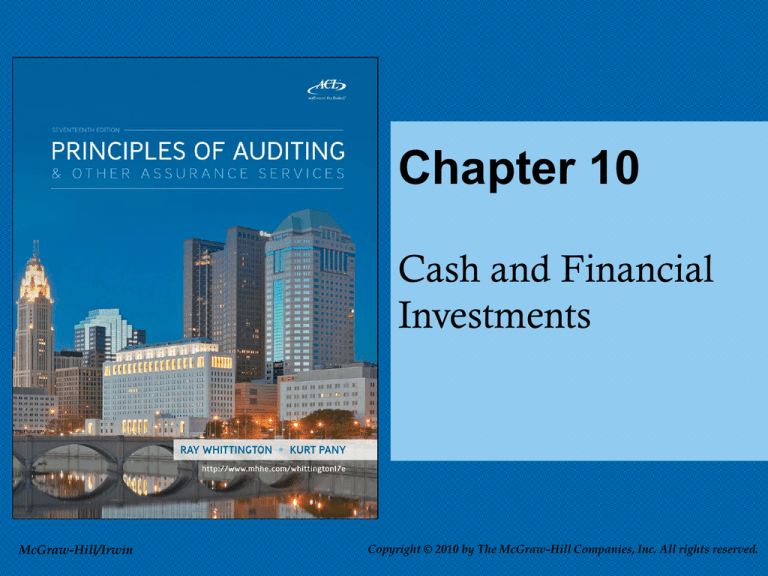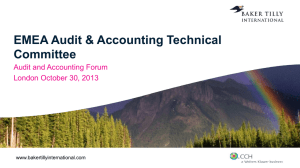
Chapter 10
Cash and Financial
Investments
McGraw-Hill/Irwin
Copyright © 2010 by The McGraw-Hill Companies, Inc. All rights reserved.
Sources and Nature of Cash
Sources
General checking account
Payroll checking accounts
Petty cash
Savings accounts
Cash
equivalents
Money market funds
Certificates of deposit
Savings certificates
10-2
Objectives for the Audit Cash
1.
2.
3.
Use the understanding of the client and its
environment to consider inherent risk,
including fraud risks, related to cash
Obtain an understanding of internal control
over cash.
Assess the risks of material misstatement of
cash and design tests of controls and
substantive procedures that:
a.
b.
c.
d.
e.
Substantiate the existence of recorded cash and
occurrence of the related transactions
Establish the completeness of recorded cash
Verify the cutoff and accuracy of cash transactions
Determine that the client has rights to recorded cash
Determine that the presentation and disclosure of
cash, including restricted funds, are appropriate
10-3
Audit time for cash
Cash
typically has a small account
balance, but auditors devote a large
proportion of total audit hours because:
Liabilities, revenues, expenses and most
other assets flow through cash
Most liquid asset so greater temptation for
misappropriation
High risk account
10-4
Management Assurance
Finance
and accounting department work
together to provide assurance that:
All cash that should have been received was
in fact received, recorded accurately and
deposited promptly
Cash disbursements have been made for
authorized purposes only and have been
properly recorded
Cash balances are maintained at adequate,
but not excessive, levels by forecasting
10-5
Guidelines for Internal Control
(1 of 2)
Do not permit any one employee to handle a
transaction from beginning to end.
2. Separate cash handling from recordkeeping.
3. Centralize receiving of cash to the extent
practical.
4. Record cash receipts on a timely basis.
5. Encourage customers to obtain receipts and
observe cash register totals.
1.
10-6
Guidelines for Internal Control
(2 of 2)
6.
7.
8.
9.
Deposit cash receipts daily.
Make all disbursements by check or electronic funds
transfer, with the exception of small expenditures from
petty cash.
Have monthly bank reconciliations prepared by
employees not responsible for the issuance of checks or
custody of cash. The completed reconciliation should be
reviewed promptly by an appropriate official.
Monitor cash receipts and disbursements by comparing
recorded amounts to forecasted amounts
10-7
Internal Control Over --Cash
Receipts
Cash sales
Involvement of two or more employees
Cash Registers
Electronic point of sales systems
Collections of receivables
Initial listing of cash receipts
Custody and depositing of cash receipts
Maintenance of customer account records
Reconciliation of customers’ ledgers with control accounts
Mailing monthly statements to customers
Collection activity and past-due accounts
Direct receipt of funds by financial institution
10-8
Cash Receipts Flowchart
10-9
Internal Control--Cash
Disbursements
Segregation of duties
Payment by check or electronic funds transfer
Pre-numbered check
Match of purchase order and receiving documents
with vendor’s invoice
Review of supporting documents by authorized check
signer
Cancel of supporting documents
Authorized check signer should mail checks
Monthly bank reconciliation
10-10
10-11
Audit of Cash (1 of 3)
A. Use the understanding of the client and
its environment to consider inherent risks,
including fraud risks, related to cash.
B. Obtain an understanding of internal
control over cash.
C. Assess the risks of material misstatement
and design further audit procedures.
10-12
Audit of Cash (2 of 3)
D. Perform further audit procedures—tests of
controls.
1. Examples of tests of controls:
a. Test the accounting records and reconciliations by
reperformance.
b. Compare the details of a sample of cash receipts listings to
the cash receipts journal, accounts receivable postings, and
authenticated deposit slips.
c. Compare the details of a sample of recorded disbursements
in the cash payments journal to account payable postings,
purchase orders, receiving reports, invoices, and paid checks.
2. If necessary, revise the risk of material misstatement based on
the results of tests of controls.
10-13
Audit of Cash (3 of 3)
E. Perform further audit procedures—substantive
procedures for cash transactions and balances.
1. Obtain analyses of cash balances and reconcile them to the general ledger.
2. Send standard confirmation forms to financial institutions to verify amounts on
deposit.
3. Obtain or prepare reconciliations of bank (financial institution) accounts as of the
balance sheet date and consider the need to reconcile bank activity for additional
months.
4. Obtain a cutoff bank statement containing transactions of at least seven business
days subsequent to balance sheet date.
5. Count and list cash on hand.
6. Verify the client’s cutoff of cash receipts and cash disbursements.
7. Analyze bank transfers for the last week of audit year and the first week of
following year.
8. Investigate any checks representing large or unusual payments to related parties.
9. Evaluate proper financial statement presentation and disclosure of cash.
10-14
Summary of Substantive Tests for Cash
Balances
10-15
Examples of fraud with cash
Do the client’s records reflect all cash
transactions that took place during the year?
Were all cash payments properly authorized and
for a legitimate business purpose?
Fraud that may be disclosed
Interception of cash receipts before any record is made
Payment for materials not received
Duplicate payments
Overpayments to employees or payments to fictitious employees
Payments for personal expenditures of officers or related parties
10-16
10-17
Potential Misstatements--Cash
Disbursements
Inaccurate
recording of a purchase or
disbursement
Duplicate recording and payment of
purchases
Unrecorded disbursements
10-18
Standard Confirmation--General
Information
Confirmation
of amounts on deposit by
direct communication with financial
institution officials
Standard form agreed to by:
AICPA
American Bankers Association
Bank Administration Institute
Addresses
only the client’s deposit and
loan balances
10-19
Standard Confirmation
10-20
Proof of Cash General Information
Reconciles the account balance and reconciles
cash transactions during a specified period.
Used to identify:
Cash receipts and disbursements recorded in the
accounting records, but not on the bank statement.
Cash deposits and disbursements recorded on the
bank statement, but not on the accounting records.
Cash receipts and disbursements recorded at
different amounts by the bank than in the accounting
records.
10-21
Proof of Cash
10-22
Check 21 Act
Checks may be processed electronically
Electronic processing creates a substitute check
– an electronic image of check
Legal equivalent of original check for all
purposes
Audit implications
Need to rely on substitute check for evidence of
check
Impossible for clients to kite checks (manipulate bank
balances to conceal cash shortage)
10-23
Kiting
Manipulations that utilize temporarily overstated bank
balances to conceal cash shortage or meet short-term
cash needs
Auditors can detect kiting by preparing a schedule of
bank transfers for a few days before and after balance
sheet date
Misstatements
Date of recording per transfer per the books are from
different financial statement periods
Date the check was recorded by the bank is from
financial statement period prior to books
10-24
Bank Transfer Schedule
10-25
Specialized knowledge to audit
financial investments
Identifying controls at service organizations that provide
financial services and are part of the client’s information
system.
Obtaining an understanding of information systems for
securities and derivatives that are highly dependent on
computer technology.
Applying complex accounting principles to various types of
financial investments.
Understanding the methods used to determine the fair values
of financial investments, especially those that must be valued
using complex valuation models.
Assessing inherent and control risk for assertions about
derivatives used in hedging activities.
10-26
Objectives for the Audit of
Financial Investments
1.
2.
3.
a.
b.
c.
d.
Use the understanding of the client and its environment to
consider inherent risk, including fraud risks, related to
financial instruments
Obtain an understanding of internal control over
financial instruments.
Assess the risks of material misstatement of financial
instruments and design tests of controls and substantive
procedures that:
Substantiate the existence of recorded financial investments
and the occurrence of investment transactions.
Establish the completeness of financial investments and
investment transactions.
Verify the cutoff of investment transactions.
Determine that the client has rights to recorded investments.
10-27
Controls Over Financial
Investments
Establishment of formal investment policies
Review and approval of investment activities by the
investment committee of the board of directors
Separation of duties among employees
1.
Authorizing purchases and sales
2.
Having custody of the securities
3.
Maintaining records
Detailed records of all securities owned and the related
revenue from interest and dividends
Registration in the name of the company
Periodic physical inspection of securities
Determination of accounting for complex instruments by
competent personnel
10-28
Audit of Financial Investments
(1 of 4)
A. Use the understanding of the client and
its environment to consider inherent risks,
including fraud risks related to financial
investments.
B. Obtain an understanding of internal
control over financial investments
C. Assess the risks of material misstatement
and design further audit procedures.
10-29
Audit of Financial Investments
(2 of 4)
D. Perform further audit procedures—tests of controls.
1. Examples of tests of controls:
a. Trace several transactions for purchases and sales of investments
through the accounting system.
b. Review and test reports of investment activity prepared for the
investment committee.
c. Inspect reports by internal auditors regarding their periodic inspection
and review of securities and derivative instruments.
d. Inspect monthly reports on securities owned, purchased, and sold and
amounts of revenue earned and budgeted.
2. If necessary, revise the risk of material misstatement
based on the results of tests of controls.
10-30
Audit of Financial Investments
(3 of 4)
E. Perform further audit procedures—substantive
procedures for investment transactions and year-end
balances.
1. Obtain or prepare analyses of the investment accounts and related
revenue, gain, and loss accounts and reconcile them to the general
ledger.
2. Inspect securities on hand and review agreements underlying
derivatives.
3. Confirm securities and derivative instruments with holders and
counterparties.
4. Vouch selected purchases and sales of financial investments during the
year and verify the client’s cutoff of investment transactions.
5. Review investment committee minutes and reports.
10-31
Audit of Financial Statements
(4 of 4)
E. further audit procedures cont.
6. Perform analytical procedures.
7. Make independent computations of revenue from
securities.
8. Inspect documentation of management’s intent to
classify derivative transactions as hedging activities.
9. Evaluate the method of accounting for investments.
10. Test the valuation of financial investments.
11. Evaluate financial statement presentation and
disclosure of financial investments.
10-32
Test Valuation
FASB
No. 133 “Accounting for Derivative
Instruments and Hedging Activities”
All derivative instruments valued at fair values
Unrealized gains or losses depend on
classification as hedges
FASB
No. 159
Allows companies to choose to use fair value
accounting rather than approach in FASB No.
133
10-33
Potential Misstatements--Financial
Investments
Misstatement
of recorded value of
investments
Unauthorized investment transactions
Incomplete recording of investments
Inadequate disclosure of the nature of
investment activities
10-34
Summary of Substantive Procedures
for Financial Investments
10-35








